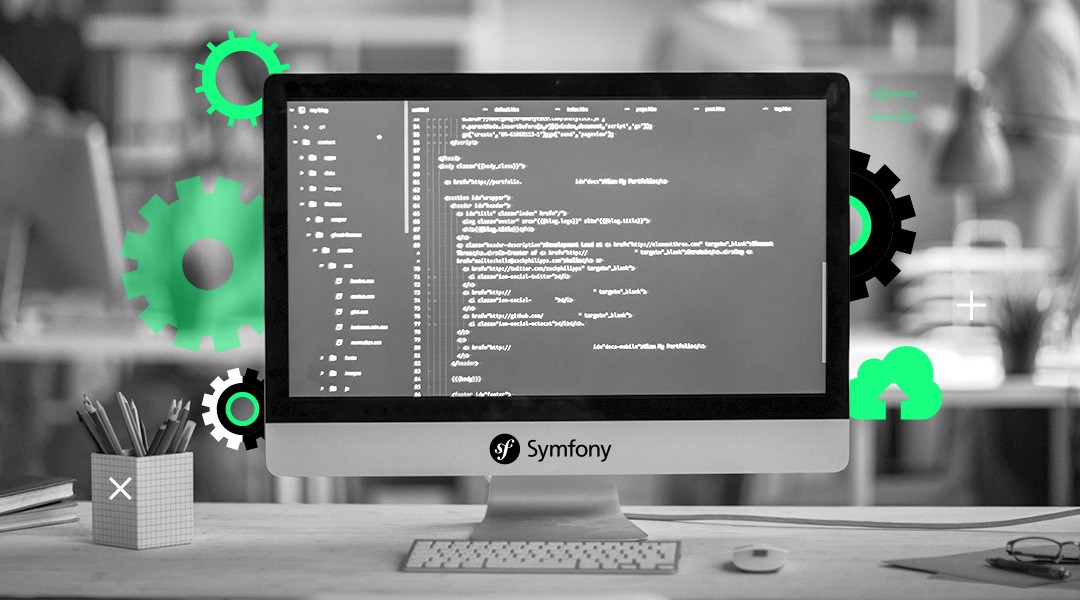 Back to blog
Back to blog
Why Use Symfony Framework for Your Project?

Web frameworks like Symfony have transformed how programming works and have become vitally important tools in the development process of even the simplest web application. Coding is used to create even the smallest unit of an application, and all that a web framework does is automate adding that code to your project.
When it comes to using Symfony as a web framework, you can try browsing dozens of articles about it. But often, all you’ll get is the same general and ambiguous information you already know, as well as terms you don’t recognize and definitions you don’t fully understand. So this article is here to break it all down and make it easier to understand why we believe that the Symfony framework is the best option when it comes to building web applications of all shapes and sizes.
What Are Web Frameworks?
Back when web development was just starting, every application was painstakingly coded by hand. And the only person who could make any changes or deploy that app was the person (or company) that developed it. However, the arrival in 1995 of a general performance testing framework changed all the hassle connected with changing the structure of an application.
And this is because it led to the development of web-specific coding languages. However, there are multiple languages to choose from, and no one can be expected to learn and be proficient in them all. This is where web frameworks come into play. With them, you can choose one framework that includes all the features you’ll need for your project. Or, you can merge several different ones.
Common Web Development Languages
For people who aren’t very tech-savvy, working with a web developer can get a little confusing when they start using phrases like CSS, HTML, Java, PHP, and more. In fact, those phrases often confuse people who are tech-savvy because they refer to such a technical aspect of the web development process.
What these phrases are referring to are the languages that a web developer uses to create and build a web app. And, different parts of a website use different languages.
HTML: This is the language that makes up the basic layout and structure of your web application. It is a dynamic code, is used as the starting point for your project, and is where the majority of static pages begin.
CSS: This is the language that is used to style your web app and controls how it is presented. It does things like adding colors and backgrounds, as well as controlling layouts, font sizes, and more.
SQL: This language is used specifically for querying databases. It is also utilized when your website has a lot of data to process. It is never used alone, though — it is always paired with other backend web development languages to get the most out of your web application.
Java: Java is one of the most popular programming languages due to the fact that it is used in the development of most Android applications. It is portable, though, so it can be run on a variety of software platforms.
Python: This is one of the easiest languages to use and work with. It can be adapted to create web applications for almost any purpose. In fact, Pinterest and Instagram are two well-known websites that are based on Python coding.
PHP: PHP makes up 79% of the internet, according to statistics. It is usually used for data-heavy websites and app development. Because Symfony is an open-source programming language, it is easy to modify. Some well-known sites using PHP include WordPress, Facebook, Spotify, and more.
Some other programming languages you may have heard of include JavaScript (not to be confused with Java), .Net, and Angular (or AngularJS).
What Is PHP?
An acronym for “Hypertext Preprocessor,” PHP started out as an open-source scripting language in 1994. PHP scripts are executed directly on the server or backend, and you can download and use any compilers or extensions you need for free. The best part is that they’ve all been developed and fully tested by others, so they’re ready to go out of the box.
Web and PHP developers embed the scripts they need to define server-side behavior and language right into the HTML markup documents that control the appearance or frontend of your web app. PHP can be used to perform the following functions, among others:
- Generating easily updateable dynamic content for your web pages
- The creation, opening, reading, writing, and closing of server files
- Collecting form data
- Sending and receiving cookies
- Controlling user access
- Encrypting sensitive user data

Why You Should Use the Symfony Framework
Excellent Reputation
Symfony was quickly adopted by professional web developers when it was first launched in 2005. It is now an internationally recognized PHP framework with a hard-earned reputation as a stable environment.
The framework has over 3,000 contributors and an experienced and supportive community of over 600,000 developers from more than 120 countries all contributing to its growth and popularity. The number of well-known brands that use the Symfony framework today attests to this, and it continues to attract even more as time goes on. Some of those brands include: (Note to customer: This information came from this link https://symfony.com/projects as well as multiple articles similar to this one https://www.softkraft.co/companies-using-php/ and this one https://trends.builtwith.com/websitelist/symfony-PHP-Framework)
- Slack
- Spotify
- Yahoo!
- Dailymotion
- Opensky.com
- Exercise.com
- phpBB
- Drupal
- WordPress
- Trivago
- Swiss Open Government Data
- National Geographic
- TED
- Vogue
Here to Stay
One of the biggest challenges that open-source software faces is the lack of funding. While developers are happy to fiddle with the code to create the tools and simplify any functionality they may need — they are often averse to sharing their hard work for free. But Symfony is one of the few frameworks with commercial backing.
Originally created by interactive agency SensioLabs, it was designed for professionals by professionals. There are conferences you can attend, official tutorials you can watch or read, and even certifications you can receive. The people behind Symfony are serious about their intentions for this framework, and this helps boost its credibility.
Incredible Flexibility
The Symfony framework is a feature-rich and intuitively organized PHP framework that is designed to make it easier for web developers to build scalable and sustainable web applications. But the two most striking pieces of technology that this framework brings to the table are Bundles and Components.
A Bundle is effectively a plugin — in other words, a small package full of PHP, JavaScript, CSS, image, or Twig files that define a certain functionality or set of functions. Their major benefit comes from the fact that they are decoupled, which allows them to be reconfigured or reused for multiple applications. And, this brings down the overall cost of development.
Components, on the other hand, are there to help reduce the work involved in routine tasks. This allows developers to focus on specific features of their application rather than mundane, repetitive tasks. You can add custom modules to use any of these 30 components independently of your main architecture, thereby not harming it in any way. It is even possible to use these components for other PHP frameworks like Laravel or when building a PHP solution from the ground up.
Easy Customization
The whole Symfony framework is packed with dozens of custom features and functionalities that both web developers and businesses will find useful. The components and bundles mentioned above are composable, so they can be ‘bolted together’ to create a tailor-made solution that consists only of the pieces you need.
In other words, with Symfony as your PHP framework, you are able to make your web app as user-oriented as you want it to be. And thanks to its use of an advanced object-oriented programming (OOP) architecture, any project you develop using the Symfony framework is infinitely scalable.
There are three core types of customization offered by the Symfony framework:
- Full-stack: You would use the full-stack Symfony PHP framework if you needed to develop a complex product with multiple functionalities. You would most likely end up using most, if not all, of the components and bundle categories available to you.
- Micro framework: Also known as Symfony 2.0, this is a reusable set of decoupled (or standalone) and cohesive PHP components that help with addressing the most common web app development problems. Unlike the main Symfony framework, this one is not based on an MVC architecture.
- Brick by brick: This is usually used by web developers who need small applications or only want to perform a specific function. Rather than using the full Symfony stack, they build their own custom framework using only a few of Symfony’s bundles and components.
Other Frequently Asked Questions About the Symfony Framework
While we hope the content above has answered most of the questions you might have about the Symfony framework and PHP in general, here are some quick answers to a few other common questions.
What is Symfony framework used for?
Symfony is one of the most popular PHP web application frameworks in the open-source developers’ community. It uses what is known as Model-View-Controller (MVC) architecture and reusable PHP components to build web applications, APIs, microservices, and web services.
Is Symfony frontend or backend?
PHP is a server-side programming language, meaning that the Symfony framework is a backend development tool. PHP belongs to the LAMP stack or Linux, Apache, MySQL, and PHP/Perl/Python stack. So, developers who use this framework need to know those syntax systems as well as HTML and CSS.
Which is better — Symfony or Laravel?
This depends on the developer. However, Symfony contains reusable components, so it offers more modularity than Laravel does. Because Symfony organizes code in a cleaner and less complex way, it is an ideal fit for projects that are larger and more complex.
Is Laravel based on Symfony?
Laravel was initially developed using Symfony components and uses Symfony as its core frame. However, Laravel uses its own logic and vision to write PHP-based software code. This vision is essentially writing intuitive code as quickly as possible. Therefore, Laravel is best for small, short-term projects.
Conclusion
Symfony is an incredibly powerful PHP framework that allows its users to build demanding web applications with as little hassle as possible. Along with the speedy development it offers, the Symfony framework has proven to be highly reliable, and the latest version provides excellent performance for even the most complex applications.
There is a steep learning curve for this product, but the Symfony framework is still PHP. You don’t need to relearn how to write code for your web app — only how to understand the code and use it in new and better ways.
The one thing about which there is no doubt, though, is that the Symfony framework is perfect for any company that needs a fully custom web application developed for their business. This is all because it is one of the PHP frameworks that gives web developers and programmers an enormous amount of freedom and a vast array of choices from the moment they start using it.
What can we do for you?
Talk to us about your project and let's start building it together!







